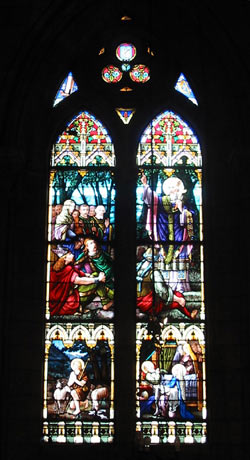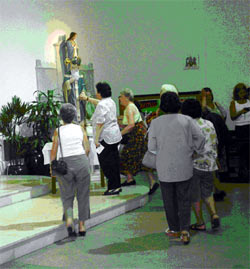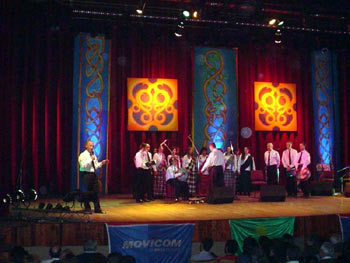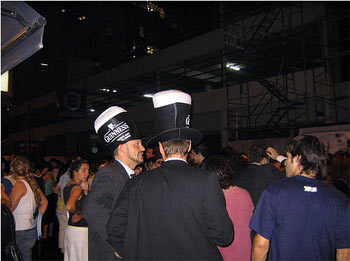|

Stained-glass window
in St. Patrick's altar at Luján Basilica, province of
Buenos Aires, donated by Margarita Morgan (née
Mooney) in 1896
(Edmundo Murray, January 2003)
|
The
liturgical celebration of the patron saint of Ireland in
Argentina
In the
context of Buenos Aires, the liturgical celebration of St.
Patrick’s Day is seen by its participants as a festival for
the Catholic community and particularly the Irish Catholic
community. This event is organised around a sequence of
religious practices, and has a special place within the
canonical calendar, where the saints are remembered
systematically each year on the day of their death in
accordance with a canon legitimised by the
ecclesiastical institution (Le Goff 1996). This context
of a religious service shares characteristics with other
commemorations; among which we find the performance of a past
fact in the here and now which simultaneously generates a
re-elaboration of its meaning in the present. In this
communicative performance, the participants consider the
celebrant a symbol of the ecclesiastical institution in the
role of the authorised performer and legitimate
narrator of a story, whose clothing and intonation, and the
very ornamentation of the temple favour the reception of a
message which attempts to achieve the audience’s support in
terms of belief (Birge-Vitz 1987). This allows for a narrative
composed like a sermon which, on the one hand, is similar to
mythic discourse in so far as it suspends temporality (Eliade
1968) and represents the patron saint as a divine mediator (Baños
Vallejo 1989), and on the other hand, emphasises the
historical dimension of the saint’s life as an effective tool
for the celebrant to achieve an ‘effect of reality’ in the
canonical narration. In this way, the mythical and historical
anchoring of the saint’s life-story acquires the paradigmatic
value of an exemplary life at the service of religious
doctrinal teaching which expresses the ethical precepts of the
group of participants (Welter op. cit.).
Another of
the characteristics of this event is shown in the liturgical
performance in St. Patrick’s church in Belgrano, where we
noted the entrance of the celebrants accompanied by the Papal,
Irish and Argentine flags, demonstrating the convergence of
religious symbolism with emblems of ethnicity. This
convergence was reflected in the allusions made by the
celebrant Fr. Eugenio Lynch, in the following terms:
‘...thinking about the patron saint of Ireland... about when
he was a child... about shamrocks... the Holy Trinity...
symbols which marked my childhood... symbols of St. Patrick,
of Ireland and Argentina... St. Patrick... a young man who was
a slave... who left his life to be a missionary... Sometimes
we lose the value... of symbols, of flags... and we are caught
up in the symbols of commerce...’ Also in the celebration, the
figure of St. Patrick was linked to ethnic emblems as
collective processes of identity construction, as set forth by
the celebrant of the Church of Santa Cruz in the question:
‘Did Ireland save the culture of a large part of Europe? An
important question…’
|

The faithful approach a
statue of St. Patrick
during a Roman Catholic celebration
(EPIF Photo Archive, 20 March 2005).
|
Finally,
in the liturgical sermon as well as in the interviews with the
different participants in the parish hall that took place at a
later date, the existence of the street parties identified
with media and commercial interests was mentioned. One of the
participants observed that: ‘We do not like the street parties
very much... because the religious significance is lost’,
while another young woman asserted ‘The street parties... as
long as the idea of celebrating the saint is maintained,
that’s fine, but getting drunk, no...’
The
surveys carried out in the rural context of San Antonio de
Areco (Province of Buenos Aires) demonstrate the same contrast
between the Festival of San Antonio de Areco, closely linked
to the liturgical celebrations and the Irish traditions, with
the excesses attributed to the ‘street’ celebrations in the
city of Buenos Aires. Furthermore, however, the traditional
Irish contribution is emphatically linked to the local
criollista tradition, as exemplified in the relationship
established by the parish priest and Irish descendants between
St. Patrick and figures like William Brown, the gauchista
author Ricardo Güiraldes and, in the present day, the
historian and journalist Pacho O’Donnell, as models of ethnic
identity.
In short,
these social actors, both urban and rural, refer to the figure
of St. Patrick as a marker of a differential identity which
concentrates religious, national and ethnic symbols in the
context of a form of celebration situated in reduced spheres.
We will now consider these festive forms and their comparison
to Celtic festivals and street celebrations.
St.
Patrick and the Celtic festivals
The
‘Celtic Festival of St. Patrick’ which was held on 18 March
2005 in the Auditorio theatre in Belgrano demonstrates
the celebration of St. Patrick as a show destined for a wider
audience. In this sense, the performance took the form of a
Celtic music and dance show, which included Galician as well
as Irish repertoires courtesy of the groups Celtic
Argentina, O’Connor Celtic Band, Na Fianna and
El bolsón de Frodo.
Without
pausing to analyse these events, which we will leave for a
future paper, it is worth mentioning how the category Celtic
has opened up to include Galician as well as Irish, and the
mention of the paradigmatic figure of St. Patrick in the
festival’s leaflets and programmes, which note his
biographical information, emphasise his role as saint, priest,
missionary and Ireland’s evangelist (‘...he travelled to
Ireland to carry Christ’s word’), emphasise the legendary
aspects of his character (‘legend has it that... he banished
the snakes from Ireland, which fled to the sea and drowned’)
and the symbols associated with his figure, such as the
shamrock and the Celtic cross. Such symbols gave rise to the
widespread marketing of icons such as shamrocks, leprechauns,
Celtic crosses, stickers of the saint, hats, T-shirts with the
shamrock icon, all of which formed part of a ‘Celtic-Expo’
which happened at the same time as the festival, in which the
selling of beer and typical Irish and Galician food were also
a feature. It is worth highlighting in this respect that
Isenbeck was sponsoring the event, and advertised its beer
in the festival’s programme.
|

Ceolraidh choir at the
Celtic Festival
(Auditorio de Belgrano, 11 September 2004)
|
In
interviews carried out with two groups of young people between
20 and 22 years old and a couple aged 52 and 57 attending the
festival, they claimed to be ‘followers of the Celtic vibe’.
They declared that their attendance at the festival was due to
their love of music and dance and the possibility of buying
crafts. When asked if they had known about the figure of St.
Patrick before, they responded negatively and referred back to
the information received at the festival, at which his
biography was read aloud by a voice ‘off-stage’. A group of
young girls said that they thought it was good that the Irish
community celebrated their festival and, also, that their was
an element of cultural exchange; but that, to be on equal
terms, ‘we Argentines should preserve and spread our
traditions.’ A young musician offered a very interesting
opinion: he said that he did not like the festival taking root
in Argentina, because of the way in which it simplified and
trivialised Celtic culture, reducing it to ‘the little
leprechauns and the little shamrock’ and used the music as an
example, defining it as ‘a mix of arrangements from various
musical styles, because original Irish music would not be very
attractive to modern listeners’. The older couple felt that
the celebration of St. Patrick’s Day in Argentina was simply a
trend that would soon pass, as they all do.
In
summary, in these festivals the figure of St. Patrick was a
pretext in order to enjoy a music and dance show of diverse
origins concentrated around the ‘Celtic’ signifier, and for
merchandising characterised by this same heterogeneity,
which even included the sale of traditional Argentine crafts,
together with crafts advertised as ‘Irish’ and, in a much
smaller number, Galician, accompanied by the sale of food and
beer from the sponsorship company, with a consumption level
that did not reach the excesses that marked the street
celebrations.
In 2006,
‘The Great Celtic Festival of St. Patrick’ held in the
Auditorio theatre in Belgrano, the repertoire of which
comprised ‘Celtic’ music and dance performed by Argentine
groups like Celtic Argentina, Na Fianna, Shiga Draoi
and others, restricted the sale of beer during the intervals
to purely ‘home-brewed’, more expensive than industrial brands
like Quilmes or Isenbeck, and resulting in the
reduced consumption of this alcoholic beverage by the
attending public. This is a clear example of the
re-appropriation of the ‘rhetoric of control’ of the previous
year’s media debate which we will examine in what follows.
|

San Martín street in
Buenos Aires, 17 March 2005
|
The
street celebrations: a diverse crowd
On 17
March 2005, some streets in the Retiro area of the city of
Buenos Aires were the stage for a crowded celebration
organised by the group of bars and breweries and the
Government of Buenos Aires, which set the scene for a
performance with its own meaning (Parente 2006). In the
past four or five years these celebrations have redefined
their exclusivity in order to attract tens of thousands of
people, the majority of whom have no connection to the migrant
group, and who consume large quantities of beer. Using
first-hand observation as a means of surveying, we noticed
that the party in Retiro mainly attracted the active
participation of young people, the majority from a
middle-class social group, particularly office staff who work
in downtown Buenos Aires and who join in the celebration after
finishing work.
In
principle, this public celebration of the Irish saint can be
considered as a kind of carnival similar to the public
holidays of the Middle Ages with their burlesque and grotesque
demonstrations far removed from the serious tone of religious
services and official parish celebrations (Bajtín 1987). In
the street parties we encounter a transformation from the
ideal to the material and physical plane demonstrated by the
behaviour of the attendees: excess, close physical contact,
the euphoric behaviour of the participants channelled through
shouting and jumping, and an uninhibited vocabulary full of
elements associated with the satisfaction of bodily desires
such as sex and drinking alcohol. In parallel, we could note
the total freedom of alcohol consumption on the streets, the
lack of official regulation with regards to the ban on cars in
the streets, and the appropriation by individuals, as
performers, of public space according to their specific
needs and desires. A police officer who was on duty that night
went so far as to affirm in a confidential tone that ‘anything
goes here’.
The
particular nuances of the celebrations in Buenos Aires are
linked to the form that the contemporary attendance took, and
its consequent redefinition of St. Patrick’s Day, which
distinguish it as much from medieval public expressions as
from the contexts of liturgical celebration. If the medieval
public carnivals are considered as a spectacle felt and lived
as something universal, by everyone and for everyone (Bakhtin
op. cit.), the feeling of Irish belonging, shared and
exalted in the celebration, disappeared in the street
carnival, and the satisfaction of the crowd, and the
expression of a specific social group to which the invitation
was aimed, all of which seemed only to indicate a feeling of
fleeting belonging born of their very attendance at the event,
where the star attraction was beer. [2] |




